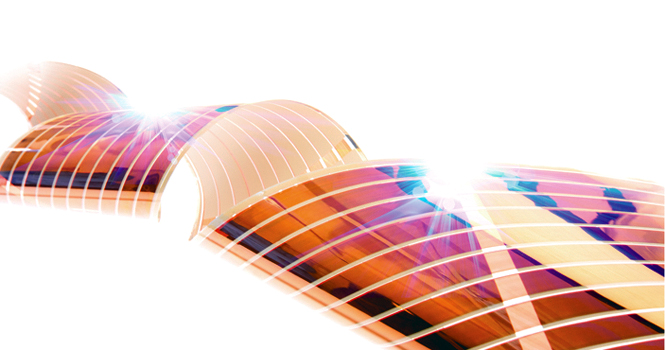Kent sees sunny future in organic solar technology
April 20, 2012
A symposium this week at Kent State highlighted a technology that could bring power to the people, literally. Imagine a house powered by a coat of paint or a skyscraper powered by its windows. Imagine a soldier charging a radio with a tarp that can be rolled up and stored in a backpack.
It may be right around the corner, and it may come from Kent State. Cool, right?
Future at Kent
FlexPV is the name of a new research initiative spearheaded by W. Grant McGimpsey, vice president of research and sponsored programs. FlexPV stands for flexible photovoltaics, which is a new generation of solar power collection. The first step in the initiative was the Organic Photovoltaics Symposium at the Kiva on Tuesday. It featured seven speakers from as far away as Japan sharing ideas about this technology.
“From a strategic point of view, energy research, especially renewable energy, is a priority,” McGimpsey said. “We have a long term commitment to faculty and work in this area.”
Alan J. Heeger is a chemist at the University of California, Santa Barbara who won a Nobel Prize in 2000 for his work with conductive polymers. They are a key component to this technology. He was the keynote speaker at the symposium. He sees a possible connection between FlexPV and another technology developed by Kent State.
“One of the great opportunities, I believe, is the use of liquid crystals,” Heeger said.
Now Hiring
Kent State administrators are trying to fill two new research positions related to organic photovoltaics: one in the chemistry department and one in the physics department.
Filling these positions won’t be cheap. Alongside paying the salaries, the school will need to invest in equipment and facilities.
McGimpsey estimates that hiring junior professors will cost the school at least $500,000, and senior faculty hires can cost as much as $2 million. He believes it is a small price to pay to bring the research here. Individual researchers usually get grants from outside sources to develop technology, but McGimpsey wants to shift the focus from individuals to a larger group.
“We want to put more and more resources into that group and achieve a critical mass of researchers on this subject. Our number one goal is collaborative relationships,” McGimpsey said. “Driving the research group to grow funding for the entire group is where the large amounts of grant money come from.”
Robert Twieg, a Kent State professor of chemistry, said he hopes to see Kent State at the forefront of this endeavor, but he is cautious. He believes for that to happen, the school must be ready with the resources and faculty needed for the endeavor and carve out a research niche.
“It’s an enormous field, and there are a lot of different components,” Twieg said.
He thinks it is a mistake to assume that Kent State has a leg up because of the school’s history with liquid crystals.
“Sorry, this is not a subset of liquid crystals,” Twieg said.
The Technology
Current solar technology relies on silicon to collect the energy. Silicon is more efficient than current polymers, but is also more expensive, hard to transport and fragile.
Instead of being put together on an assembly line, these solar cells can be made in a roll-to-roll process, similar to printing. It is like the difference between an assembly line making cars and a printing press making newspapers.
“There is a potential for mile-a-minute production,” said Paul Berger, a researcher at the Ohio State University.
For all of its benefits, flexible photovoltaics have a few downsides. They are sensitive to moisture, and barrier films that can protect them from water are still not cost effective.
Berger believes that once everything falls into place, organic photovoltaics will make a lot of economic sense compared to other forms of energy production.
“If you can improve the lifetime of this technology, it is like printing money,” Berger said.
What it may mean for the world
Flexible solar panels may someday be thin enough to be stuck onto surfaces like a decal, or even built into windows. The flexible nature of the panels would also make the technology easier to transport, making it more viable for third world nations, hard to reach rural areas or war zones.
“People have tried to take traditional solar cells into the third world, the roads are bumpy, and often the product never really gets there,” Heeger said. “It breaks down. These things are rugged and they can take a lot of punishment.”
Brett Ellman, Kent State associate physics professor, sees a bright future for organic photovoltaics.
“The ultimate dream would be a paint you could put on your house and make the entire house a solar cell,” Ellman said. “That would be cool, right?”
Contact Mark Haymond at [email protected]

























